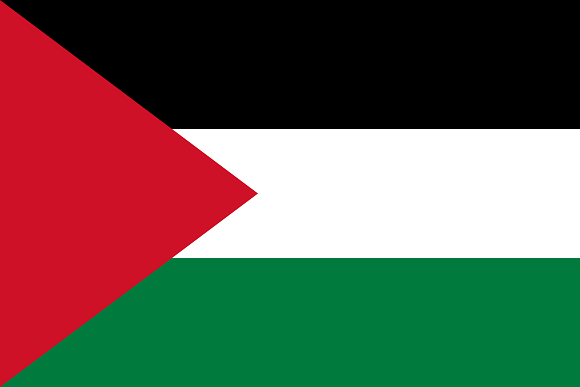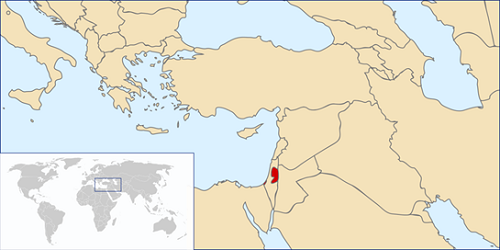
Geography

Source: This image is the intellectual property of Rei-artur. Redistribution under licence CC BY-SA 3.0
Area: 6,220 km2 (3,54% water)
Coastline: 40 km
Terrain: Mainly dry and rugged soil, consisting of barren land to the east and some vegetation to the west (West Bank); flat coastal plain covered with sand and dunes (Gaza)
Highest point: Mount Nabi Yunis 1,030 m (south West Bank)
Climate: Warm summers and cool to mild winters (West Bank); mild winters and hot and dry summers (Gaza)
Geographical population distribution: In Gaza the population is distributed across all its area. In the West Bank, Arabs are concentrated mainly in the central and west part of the area while Jews are concentrated mainly in the north and around Jerusalem
Natural resources: arable land, natural gas (Gaza)
Demographics
Population:4,803,270 (2020)Annual population growth: 2.5% (2020)
Population estimate 2025: 5,718,000
Population distribution by age group (2020)
0-14 – 38%
15-64 – 58%
65+ – 3.0%
Fertility rate: (births per woman): 3.6 (2019)
Birth rate: (births per 1000 people): 29 (2019)
Death rate (deaths per 1000 people): 3 (2019)
Median age: 19.5 years (2015)
Life expectancy (at birth): 74 years (2019)
Males – 72 years
Females – 76 years
Net migration: -52,816 (2017)
Language: Arabic is the offiial language of the Palestinian Authority
Religious groups: Sunni Muslims 71.7%, Jews 11.3%, Other Muslims 9.6%, Non-religious/atheists 5.7%, Christians (mainly Greek Orthodox) 1.5%, Other religions 0.1% (2015)
Ethnic groups: Arabs 88.7%, Jews 11.3% (2015 – estimates based on religious groups)
Economy
GDP: $15.56 bil(2020)
GDP per capita: $3,239.7 (2020)
GDP annual growth rate: -11.5% (2020)
Public debt (% GDP): 37.3% (2019)
Inflation (CPI): -0.7% (2020)
Unemployment: 27.4% (2020)
Imports $6.6 bil (2019)5 largest import partners (% total imports - 2019): Israel 54.98%, Turkey 10.12%, China 6.76%, Jordan 4.48%, Germany 2.74% Exports: $1.1 bil (2019)
5 largest export partners (% total exports - 2019): Israel 81.31%, Jordan 6.47%, United Arab Emirates 2.94%, United States 1.80%, Saudi Arabia 1.75% Global Competitiveness Report (World Economic Forum)
-
Index of Economic Freedom (Heritage Foundation)
- Income Inequality Index (Gini – World Bank)
33.7% (2016) Prosperity Index (Legatum Institute)
-
Military Power
Active personnel: 30,000 (2020)Politics and Government
Form of government: Semi-presidential
President: Mahmoud Abbas (2005)Prime Minister Mohammed Shtayyeh (2019)
Executive branch: Executive power is shared between the President and the Council of Ministers. According to the constitution, the President is elected in direct elections and can serve up to two consecutive 4-year terms (the last elections were held in 2005). The Prime Minister is appointed by the President and is responsible with forming the government.
Legislative branch: The constitution states that legislative power is exercised by the Legislative Council which consists of 132 elected representatives for a 4-year term (the last elections were held in 2006).
Judicial branch: The judicial branch of power consists of the General Prosecutor, the Bar Association, the Supreme Judicial Council and the Constitutional Court that was founded in 2016. The Supreme Judicial Council supervises the court system and nominates judges. Judges are appointed upon approval of the President of the Palestinian Authority. The court system is comprised of first-instance, second-instance, Islamic and other courts. All three branches of power face functionality issues due to the serious disagreements between Fatah and Hamas and the limited sovereignty of the Palestinian Authority in general.
Parliamentary parties: There are no parliamentary parties currently as the President of the Palestinian Authority dissolved the Parliament in December 2018 following a ruling by the Constitutional Court. The Parliament was dominated by Hamas who held 74 out of 132 seats. Fatah held 45 seats while the rest of the seats were occupied by smaller parties and independent representatives.
Last elections: Parliamentary elections 2006 – Hamas 44.45%, Fatah 41.43%, Martyr Abu Ali Mustafa 4.25%, The Alternative 2.92%, Independent Palestine 2.72%, Third Way 2.41%, Other parties 1.81%. Voter turnout was at 76%Next elections: Parliamentary elections possibly in 2020
Rule of Law - Human Rights
Corruption Perceptions Index(Transparency International)- Rule of Law Index (World Justice Project)
- Global Terrorism Index (Institute for Economics & Peace)
5.177/10 (2019 – position 32/163) Fragile States Index (Fund For Peace)
86/120 (2021 – position 37/179) Democracy Index (Economist Intelligence Unit)
3.83/10 (2020 – position 113/167) Press Freedom Index (Reporters Without Borders)
29.44/100 (2021 – position 132/180) Freedom in the World Index (Freedom House)
West Bank: 25/100 (2021)
Gaza Strip: 11/100 (2021)




